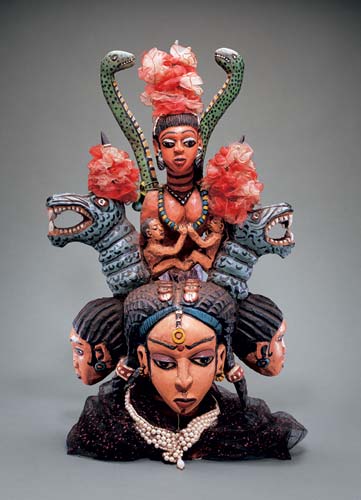
 |

Mami Wata is a complex symbol with so many resonances that she feeds the imagination, generating, rather than limiting, meanings and significances. She is at once a nurturing mother; sexy mama; provider of riches; healer of physical and spiritual ills; and embodiment of dangers and desires, risks and challenges, dreams and aspirations, fears and forebodings. People are attracted to the seemingly endless possibilities she represents and, at the same time, frightened by her destructive potential. She inspires a vast array of emotions, attitudes, and actions among those who worship her, fear her, study her, and create works of art about her.
Often appearing with the head and torso of a woman and the tail of a fish, Mami Wata straddles earth and water, culture and nature. She may also take the form of a snake charmer, sometimes in combination with her mermaid attributes and sometimes separate from them. She can exist in the form of indigenous African water spirits known as mami watas and papi watas or assume aspects of a Hindu deity or a Christian saint without sacrificing her identity.
This section of the exhibition presents a broad overview of some of the movements, images, and ideas that have played major roles in the arts for Mami Wata. These include African images celebrating ancient and indigenous water spirits, global examples that demonstrate the transcultural nature of Mami Wata, and contemporary ideological and theological controversies concerning good and evil.
|

Dona Fish
Ovimbundu peoples, Angola
Circa 1950s-1960s
Wood, pigment, metal, mixed media
Private Collection
Photo by Don Cole.
| |

John Goba (b. 1944, Mattru Jong, Sierra Leone)
Headdress, 1980s (?)
Wood, pigment, fabric, netting, beads, metal fiber
Collection of Mr. and Mrs. Jeremiah Cole
|
|
|
|
|